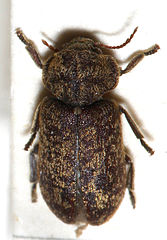
Classificatio n
n
Scientific Name: Xestobium rufovillosum
The name means "bores through wood making a ticking sound to
foreshadow death." (Audio
English, 2005).
Common Name: Deathwatch beetle
The origin of the name the death watch beetle is known as an omen of
death. When people heard the ticking noise on a sleepless
night they would associate the ticking sound as a precursor to death
(Jnine
pest control, 2009).
Domain: Eukarya
The death watch beetle is in the domain Eukarya because it contains a membrane bound nucleus (Hickman
et. al., 2009).
Kingdom: Animalia: The death watch beetle is in the kingdom Animalia
because it is heterotrophic, they have separate sexes, and contains
eukaryotic cells (Hickman et. al., 2009).
Phylum: Arthropoda
The death watch beetle is in the phylum Arthropoda because it contains jointed appendages, a chitonous
skeleton, and a compound eye (Gillis, 2012).
Class: Insecta
The death watch beetle is in the class Insecta because it contains
characteristics of six legs, a waxy cuticle to resist hydration, and
developmental of flight (Gillis, 2012).
Order: Coleophera
The death watch beetle is found in the order Coleophera because it contains characteristics of a hardened forewing,
abdominal sterna sclerotized, terga soft, mouth parts mandibulate (Csiro,
2009).
Family: Anobiidae
The death watch beetle is in the family Anobiidae because it
has contractile legs and a strongly deflexed head (Nicholas,
1973).
Genus: Xestobium
The death watch beetle is in the genus Xestobium because it
is woodboring and makes a ticking sound on the wood (Audio
English, 2005).
Species: Xextobium rufovillosum
Home